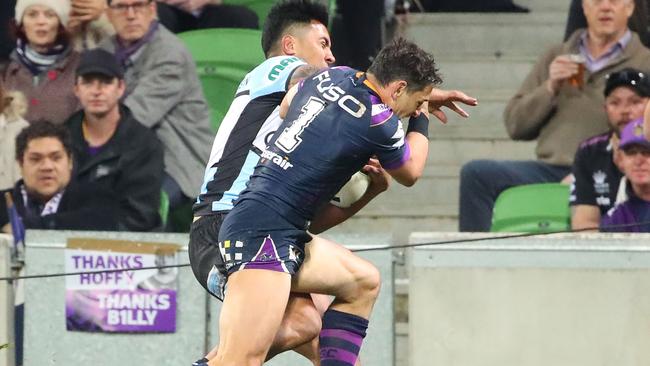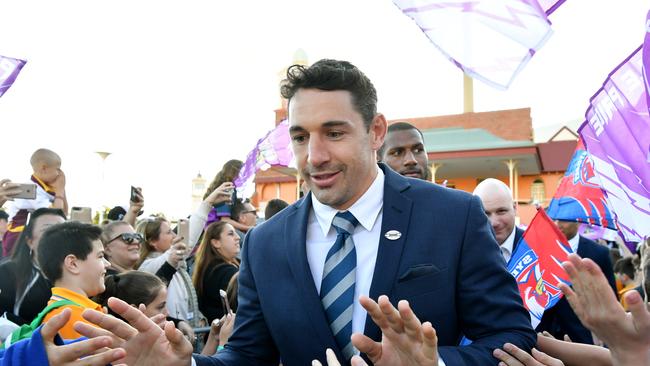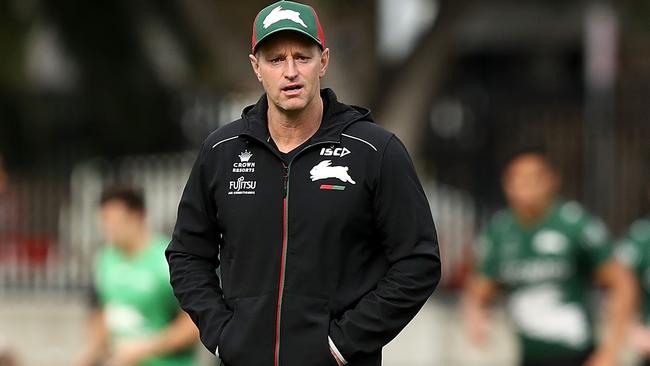Paul Kent: Billy Slater sold his best ever dummy at the NRL judiciary
BILLY Slater’s address to the judiciary tribunal may have swung the balance in his favour and the fact his evidence wasn’t rebutted was a big mistake, writes Paul Kent.
Storm
Don't miss out on the headlines from Storm. Followed categories will be added to My News.
BILLY Slater plays on Sunday because the argument got splintered at every level and the NRL lacked either the smarts or fortitude to intelligently present their case.
Slater’s presence in the grand final is great for the short term future of the game but offers a worry for its long term future.
At no point during the week, among all the debate, was there a clear strong voice from the NRL that cut through the irrelevant and misleading argument.
The narrative splintered and changed at every level.
Yet still the NRL was unable to defend it.
The confusing arguments that helped to get Slater off began with an argument that basically conceded it was a shoulder charge but was argued with a question: how else was he supposed to stop a try?

Nobody bothered to argue that if Slater really did have no other option then, perhaps, it was defensive error in the lead-up and Sosaia Feki deserved to score in the corner.
Quickly the argument then changed to whether that tackle was worthy of missing a grand final.
Much of it was understandable, if misguided. It was coming from those who had close personal relationships with Slater.
Once Slater was charged the posts needed to be moved again so argument began about the charge and whether the judiciary panel, faced with actually making the decision, should apply the “common sense” rule.
This rule was twisted to support the argument that Slater had done a lot for the game and should not be rubbed out of his final game, a grand final at that, for a shoulder charge when three years ago shoulder charges were okay. And how else was he supposed to stop a try, anyway?
Few picked up the absurdity that the common sense defence actually runs in defiance of actual common sense, which is that a rule is a rule and that Slater knew the rules and the minimum punishment before he made the shoulder charge.
It went to another level once the hearing began, though.

At no point was there a clear strong voice from the NRL about why the shoulder charge needs to be vigorously defended
Instead, it was as if the NRL was keeping one eye on Slater and the other on ticket sales.
Slater prepared meticulously for the hearing and seems to have gambled the judiciary prosecutor was not as diligent.
Then he pulled a masterstroke, standing and addressing the tribunal himself.
“I watched every try of both their wingers throughout the in the build up to the game,” Slater said. “I noticed Feki had scored eight tries by pinging for the corner. I knew he liked to back himself.
“I realised Sosaia was 10 metres from the corner post. My intention was to make a ball and all tackle. “I’m intending to get my body in front of Feki between the try-line.
“But he stepped of his left foot and I’m running at 33kph and I’ve got two metres to make a decision.”
It was compelling.
It was persuasive.
And it was false.
Not once in the eight tries Feki scored this season did the cover defence come across in front of him like Slater did.
Seems nobody bothered to check.
Feki’s first try came round two against St George Illawarra. He got the ball in space and Jason Nightingale came across in cover and Feki headed straight for the tryline. Nightingale hit him around the hips, slightly from behind.

His second and third tries were against Parramatta. The first he strolled in, bringing the ball around slightly to improve the position. No pinging required.
The third he went for the corner, slightly high and similar to the Slater incident, but the defence was further away than Slater and Parramatta could get only an arm to him.
The fourth, against Canberra, Feki pinned his ears and went for the corner. As the cover defence loomed he got ankle tapped and stumbled on his last step, falling over the tryline.
A smart prosecutor could have argued that while there are instances of Feki “pinning his ears” and jamming for the corner, none mirrored the circumstances of last week.
According to his own testimony, Slater was well enough in front of Feki that it was his left pectoral muscle that made first contact.
The fifth try against Newcastle had similarities to the Slater tackle. Feki went for the corner while Shaun Kenny-Dowall tried to push him into touch.
Kenny-Dowall was not close enough to get body contact and, again, was coming from behind.
His sixth and seventh tries came against Canterbury in the final round.
The sixth was against a dirty defence, the Bulldogs scrambling to shut Cronulla down. Feki got the ball with limited space and dived over in the corner. There was no option to step infield.

The seventh was the opposite. Feki got the ball 30m out and had clear air all the way to the tryline and brought it around to improve the grounding.
He caught the ball behind him for his eighth and final of the season against the Sydney Roosters in the first week of the playoffs. It forced him to spin away from the defence and then dive in the corner.
Crucially, in not one of those tries does Feki have a cover defender coming across from in front — essentially negating Slater’s evidence about all eight tries.
But it was allowed to go untested.
This part of Slater’s defence was so compelling.
It detailed the knowledge Slater was supposed to have ready for instant recall in the moments before the Feki tackle to explain why he took the only option, supposedly, there was left to take.

In reality, in all eight tries Feki did what every other good winger in the competition does, which was adapt to the defence. No difference.
In not one of the others was there a cover defender coming across in front of Feki.
Slater argued he believed Feki was gearing up to step inside him. The evidence being Feki stepping off his left foot to slightly change position before impact.
These are the two metres Slater spoke of.
A more vigorous prosecution could have rebutted Slater’s assessment by arguing Feki saw Slater coming across in front of him and was simply preparing for impact by changing his centre of balance.
That Feki did in fact do what Slater studied him to do, which was go for the corner.
The Slater case split the rugby league community. Each side fiercely holds position.
There is a feeling Slater pulled off another miracle save.
And rather than his appearance in the grand final being a good result for the game, as the early narrative went, the opposite is now true.

MAGUIRE A SOLID OPTION FOR BRISBANE
FOR years, there were two types of coaches in rugby league.
There were the man-managers, those who basically graduated from the Jack Gibson school of coaching.
They preached personal accountability and improvement.
The other kind were the tacticians. The coaches who broke down the game’s science and coached tactics and Xs and Os. They basically graduated from the Warren Ryan school of coaching.
Wayne Bennett is from the Gibson school. Strong clubs often worked on the theory of switching from one school to the next with each appointment. It was the best way to give their players the strongest schooling.
In recent years, the emergence has been a blend of the two, the likes of grand-final coaches Craig Bellamy and Trent Robinson.
In the era of full-time coaching, it is not just necessary but compulsory. For such reasons, Michael Maguire is a solid option to replace Bennett at Brisbane after the Broncos confirmed this week that Bennett and the club would part ways after the 2019 season.
Maguire is strong tactically and would bring an edge to the Broncos different to what Bennett brings.
He is from the Bellamy school, the all-rounders, popularising the game at the moment.
Get ready for cricket like never before. FREE Sport HD + Entertainment until the first 4K cricket ball as part of 3 months free on a 12 month plan. SIGN UP TODAY. T&Cs apply.
